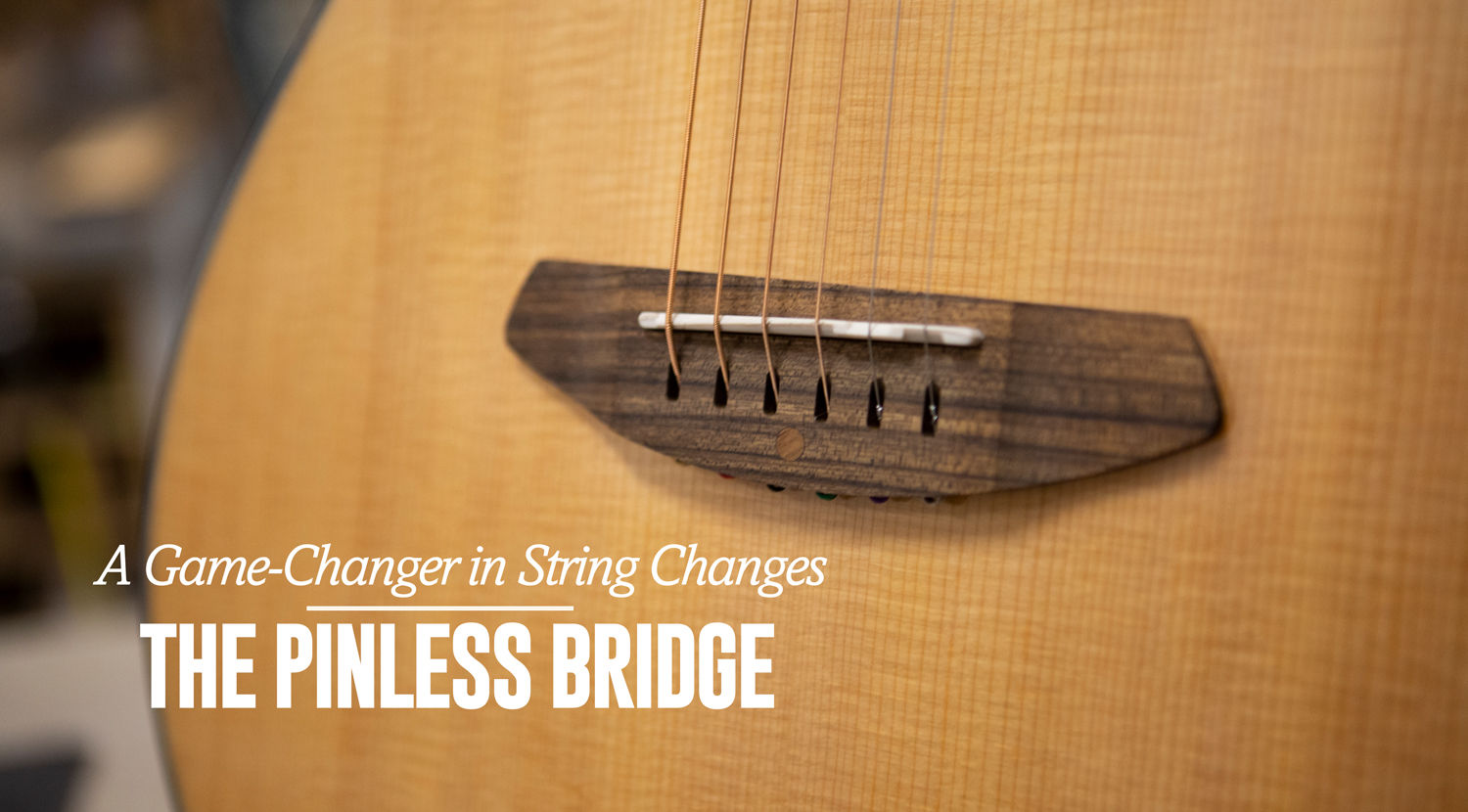
Plus Four More Reasons You Need to Try One
The design of acoustic guitar bridges has remained largely unchanged since the introduction of steel-string flat-tops. For decades, the trusty pin-through-the-guitar-top design has been the norm. While there have been attempts to evolve this design paradigm over the years, such as Gibson’s adjustable saddles and Peavey’s acoustic guitar tremolos, the bridge pin continued to reign supreme.
However, this doesn’t mean the design is flawless. Pinned acoustic guitar bridges come with a few drawbacks. They necessitate six additional holes through the guitar’s soundboard, and the pins themselves are prone to getting lost or broken, making replacement a troublesome task. Moreover, they can make restringing your acoustic guitar a tedious process.
We believed it was time for an upgrade, which is why we introduced the Breedlove pinless acoustic guitar bridge. With no pins to contend with, our bridge eliminates the need for additional drilling through the guitar top, simplifying the process of changing strings and even enhancing your Breedlove’s sound.
Still not convinced? Let’s explore a variety of structural, tonal, and player benefits that the pinless bridge offers, beginning with its innovative design.
Inspired by Electric and Classical Guitar Bridges
At first glance, our pinless bridge may appear deceptively simple. It shares similarities with some solid-body electric guitar bridges in that you load the strings from the back of the bridge, rather than through the body of the instrument. Classical acoustic guitars sport a similar design, but only our pinless bridge bridges the gap between them and a steel-string acoustic guitar, allowing you to use any standard set of steel acoustic guitar strings with a ball end.
Maintaining Your Soundboard’s Integrity
Standard pin-based acoustic guitar bridges hide an unattractive secret. They require six additional holes to be drilled through your guitar’s soundboard. Your strings aren’t anchored in the bridge itself but are instead wedged against the top’s open grain, putting a lot of pressure on it. To counteract this stress, luthiers typically insert a thicker piece of hardwood under the bridge, known as a bridge plate.
The Breedlove pinless bridge eliminates the need for these additional holes, thereby preserving the structural integrity of our acoustic guitars’ soundboards. This is particularly advantageous because the bridge allows for thinner, more resonant tops and permits the strings’ vibrational energy to transfer across the instrument without interruptions caused by modifications to the tonewood.
The Pinless Bridge Makes String Changes a Breeze
Learning how to change acoustic guitar strings is a skill in itself, and many players never master it. Even lifelong guitarists often procrastinate when it comes to string changes, primarily due to the hassle of dealing with bridge pins. The process becomes effortless with our pinless bridges. Changing strings is as simple as threading the string through the correct hole in the back of the bridge, pulling it through, wrapping it around the tuning post, and tuning it up. It’s that easy and can be completed in just a few minutes. This is why our 12-string acoustic guitars have gained such popularity.
Note: Don’t forget to stretch the strings!
Never Break or Lose a Bridge Pin Again
One of the most significant advantages of pinless bridges is the elimination of bridge pins themselves. Anyone who has changed strings on a pin bridge design knows how easy it is to lose the pins or, even worse, break one. Furthermore, most pins are slightly different from each other, making it nearly impossible to replace just one and maintain the consistent look of your guitar. Lose one pin, and you might end up replacing the entire set.
How many pins will you lose or break on a Breedlove? Hint: 0
Break Angle Over the Bridge Saddle
Another structural and tonal benefit of our pinless bridge stems from its shallower string break angle over the bridge saddle. You’ve likely seen an acoustic guitar with a bridge that’s lifting off the guitar’s top. While this phenomenon is caused by various factors, the strain that strings exert on the saddle is always a contributing factor. With sharp break angles, the strings exert significant forward pressure on the saddle, causing it to tip and pull away from the soundboard. This diminishes the downward pressure on the top where it should be.
Our gentler break angle addresses both of these issues. More pressure is directed downward rather than forward, allowing the string’s power to be transferred into the top, preventing the bridge from pulling forward off your guitar. This is yet another reason we can offer our incredibly sounding, thinner soundboards while maintaining optimal stability.
They Feel Great
The Breedlove pinless bridge is instrumental in capturing the famed ergonomics of our guitars. While you may not typically think of a bridge as an ergonomic consideration, ours features a sleek, low-profile design. Try playing one of our guitars, and you’ll likely notice that your picking hand comfortably accommodates palm-muted passages. The bridge’s contours seamlessly blend into the top without any protrusions into the side of your palm. It may seem like a minor detail, but when you try it, you’ll understand the difference it makes.
The (String) Wrap
We often talk about the innovations we bring to acoustic guitar design, but the pinless bridge tends to fly under the radar. While it might not be as recognizable as our bridge truss system or Sound Optimization process, it plays a significant role in what makes our guitars unique. From streamlining maintenance to enhancing the sound of our instruments, there’s much more to these bridges than meets the eye.
Next time you play one of our guitars, pay attention to the pinless bridge, and you’re likely to fall in love with an aspect of acoustic guitar design you may not have noticed before.
